PBS News: January 31 and February 1 – 3, 2020
Aspeer: This Helipad in Bangkok has been Transformed into a 4000 sqm Hydroponic Farm
The Farmacy: HYDROPONIC Farm Tour
Roald Boom: Commercial Hydroponics on Bonaire – part 1 & 2
TED Talks: Dena Simmons How students of color confront impostor syndrome. Victor Rios Help for kids the education system ignores, Sal Khan let’s teach for mastery not test scores, and Sal Khan let’s use video to reinvent education
Charlotte Observer: Sixty years ago, four college students sat at a lunch counter — and made history
Thisiscolossal: ? Portraits of Venezuelan Families Reframe the Harrowing Journey of Immigrants, The Extraordinary Details of Tiny Creatures Captured with a Laser-Scanning Microscope by Igor Siwanowicz, ? Striking Photographs Capture Ornate Patterns of Historic Iranian Mosques and Palaces and Forest Creatures Gather Together to Perform a Moonlit Rendition of an Opera
Bloom PicturesPRO: Maestro, Maestro – Making of, and Garden Party
PBS NewsHour full episode, Feb 3, 2020
Feb 3, 2020 PBS NewsHour
Monday on the NewsHour, Iowa Democrats caucus in the country’s first 2020 primary voting. Plus: What happens next in President Trump’s Senate impeachment trial, Politics Monday analyzes the Iowa Democratic caucuses and the Senate trial, how U.S. public health officials are reacting to the novel coronavirus threat and an artist and benefactor steps out from the shadows to support her female peers. Stream your PBS favorites with the PBS app: https://to.pbs.org/2Jb8twG Find more from PBS NewsHour at https://www.pbs.org/newshour Subscribe to our YouTube channel: https://bit.ly/2HfsCD6
PBS NewsHour Weekend full episode February 2, 2020
•Feb 2, 2020 PBS NewsHour
On this edition for Sunday, February 2, a look ahead to the Iowa caucuses and how they have changed, international quarantines expand as the death toll from the novel coronavirus rises, Venezuela’s opposition leader visits the U.S., how misconceptions impact gender in sports, and what Lebanon is doing to fight food insecurity among refugees. Hari Sreenivasan anchors from New York. Stream your PBS favorites with the PBS app: https://to.pbs.org/2Jb8twG Find more from PBS NewsHour at https://www.pbs.org/newshour Subscribe to our YouTube channel: https://bit.ly/2HfsCD6
PBS NewsHour Weekend full episode February 1, 2020
Feb 1, 2020 PBS NewsHour
On this edition for Saturday, February 1, the Senate impeachment trial winds down after Republicans vote to exclude new evidence, Brexit is official as Britain charts a new course amid divisions in the country, and our “Future of Food series” looks at how Jordan is using technology and innovation to help refugees facing food shortages. Hari Sreenivasan anchors from New York. Stream your PBS favorites with the PBS app: https://to.pbs.org/2Jb8twG Find more from PBS NewsHour at https://www.pbs.org/newshour Subscribe to our YouTube channel: https://bit.ly/2HfsCD6
PBS NewsHour full episode, Jan 31, 2020
Jan 31, 2020 PBS NewsHour
Friday on the NewsHour, the Senate has decided not to allow the subpoenaing of witnesses in President Trump’s impeachment trial, which could end more quickly as a result. Plus: The Trump administration adds limitations on travel to the U.S. from certain countries, a preview of Monday’s Iowa Democratic caucuses, the political analysis of David Brooks and Ruth Marcus and honoring Jim Lehrer. WATCH TODAYS SEGMENTS Why a Senate majority rejected impeachment trial witnesses https://www.youtube.com/watch?v=jF2jm… News Wrap: United Kingdom officially exits European Union https://www.youtube.com/watch?v=TStEA… How Trump’s new visa restrictions will affect U.S. families https://www.youtube.com/watch?v=gifwh… Iowa voters excited, anxious before critical Dem caucuses https://www.youtube.com/watch?v=fatIM… David Brooks and Ruth Marcus on impeachment witnesses, Iowa https://www.youtube.com/watch?v=YupGo… Loving tributes to Jim Lehrer from those who knew him best https://www.youtube.com/watch?v=pJ6NO… Stream your PBS favorites with the PBS app: https://to.pbs.org/2Jb8twG Find more from PBS NewsHour at https://www.pbs.org/newshour Subscribe to our YouTube channel: https://bit.ly/2HfsCD6
This Helipad in Bangkok has been Transformed into a 4000 sqm Hydroponic Farm
Jun 10, 2017 Aspeer
music credits: Central Park – Instrumental | Blockhead # About Aspeer Aspeer is a platform dedicated to sharing sustainable and tangible initiatives favouring a transition towards a new model of society. A model reconciling the social, environmental and economic issues. # Subscribe Subscribe to our Newsletters: http://eepurl.com/cEPcYz Youtube Channel: https://goo.gl/mYp5ag Like us on Facebook: https://www.facebook.com/aspeer.co Follow us on Instagram: https://www.instagram.com/_aspeer Website: https://www.aspeer.co
Category People & Blogs
HYDROPONIC Farm Tour
Mar 1, 2018 The Farmacy
Commercial Hydroponics on Bonaire – part 1
Aug 4, 2014 Roald Boom
http://roaldboom.com/ https://www.facebook.com/roald.boom This video is the first part of a series of videos demonstrating the setup of a 5000 square foot greenhouse on Bonaire. Green Bonaire is building 5 greenhouses of each 500 square feet at Krusada. They have contracted me as a consultant to help them install a DWC hydroponic system in one of the greenhouses. The greenhouse will be able to produce over 1000 heads a week. This first video shows the progress of the construction of the greenhouse structures themselves.
Commercial Hydroponics on Bonaire – part 2
Jan 29, 2016 Roald Boom
This is the part 2 of the Commercial Hydroponics on Bonaire project at Krusada. The owners of Green Bonaire are Jaap and Pieter. Jaap has a background in Agriculture and he is the one in charge of the whole operation. Jaap contacted me many months ago for consulting and I have assisted them with this one tunnel greenhouse. They have several tunnels and this one is setup as 100% hydroponics using the methods that I have been using at my own greenhouse at URD Solution. The greenhouse is now fully operational and has a full cycle that produces over 150 heads of lettuce a day, excluding Saturday and Sunday. It is a non-circulating hydroponics system and it is working very well.
As a black woman from a tough part of the Bronx who grew up to attain all the markers of academic prestige, Dena Simmons knows that for students of color, success in school sometimes comes at the cost of living authentically. Now an educator herself, Simmons discusses how we might create a classroom that makes all students feel proud of who they are. “Every child deserves an education that guarantees the safety to learn in the comfort of one’s own skin,” she says.
This talk was presented at an official TED conference, and was featured by our editors on the home page.
TED Talks Live | November 2015
Define students by what they contribute, not what they lack — especially those with difficult upbringings, says educator Victor Rios. Interweaved with his personal tale of perseverance as an inner-city youth, Rios identifies three straightforward strategies to shift attitudes in education and calls for fellow educators to see “at-risk” students as “at-promise” individuals brimming with resilience, character and grit.
This talk was presented at an official TED conference, and was featured by our editors on the home page.
Victor Rios · Educator, author
Would you choose to build a house on top of an unfinished foundation? Of course not. Why, then, do we rush students through education when they haven’t always grasped the basics? Yes, it’s complicated, but educator Sal Khan shares his plan to turn struggling students into scholars by helping them master concepts at their own pace.
This talk was presented at an official TED conference, and was featured by our editors on the home page.
Sal Khan · Educator and social entrepreneur
TAKE ACTION
LEARN
You can learn anything. Your brain is like a muscle. The more you use it, the more it grows.
PARTICIPATE
Donate to Khan Academy and help provide a free, world-class education for anyone, anywhere.
3,619,583 views
TED Talks Live | November 2015
Salman Khan talks about how and why he created the remarkable Khan Academy, a carefully structured series of educational videos offering complete curricula in math and, now, other subjects. He shows the power of interactive exercises, and calls for teachers to consider flipping the traditional classroom script — give students video lectures to watch at home, and do “homework” in the classroom with the teacher available to help.
This talk was presented at an official TED conference, and was featured by our editors on the home page.
Sal Khan · Educator and social entrepreneur
https://www.charlotteobserver.com/news/local/article239561018.html
Sixty years ago, four college students sat at a lunch counter — and made history
BY JIM MORRILL JANUARY 29, 2020 05:30 AM Loaded: 52.78%
WBTV reporter Steve Crump is currently completing two documentary projects on the Greensboro sit-ins and on civil rights icon U.S. Rep. John Lewis, while battling cancer. He sees this work as a gift to making a positive difference in the community. BY DAVID T. FOSTER III
Sixty years ago, Saturday, four black college students sat down at a lunch counter in Greensboro and ordered coffee.
Their simple act launched a sit-in movement that swept the Jim Crow South and made the four student’s icons in America’s civil rights history.
Now the event is the heart of two new documentaries by Charlotte journalist Steve Crump, a longtime chronicler of the civil rights years. In many ways they reflect his own personal journey.
The first features the late Franklin McCain, a former Charlottean who led the four N.C. A&T students into the segregated Woolworth on that February day. It debuts Feb. 5 at the Harvey B. Gantt Center for African-American Arts and Culture.
The other focuses on U.S. Rep. John Lewis of Georgia, a veteran of the sit-ins, Freedom Rides and Martin Luther King’s 1963 March on Washington.
The men who became known as the Greensboro Four — McCain, Ezell Blair Jr., David Richmond and Joseph McNeil — started a movement that within weeks would spread to 55 cities in 13 states.
“To me it was one of the turning points in history,” said Clayborne Carson, director of Stanford University’s Martin Luther King Jr. Institute. “That’s just as remarkable as Rosa Parks refusing to give up her seat. It’s an example of how movements are often started by people dealing with problems right in front of them.”
A portion of Greensboro’s once whites-only lunch counter is at the Smithsonian National Museum of American History. The old downtown Woolworth is now the site of the International Civil Rights Center & Museum, which will mark the occasion with its annual gala.
A statue of the four students who staged a civil rights sit-in at a Greensboro lunch counter in 1960 stands on the campus at N.C. A&T University in Greensboro NC on Jan. 23, 2014. They are (L:R) David Richmond, Franklin McCain, Ezell Blair, Jr., and Joseph McNeil. For story on the state of historically black universities in North Carolina, of which A&T is one. Chris Seward CSEWARD@NEWSOBSERVER.COM
On the N.C. A&T campus, the four men are commemorated in a 15-foot bronze statue.
In Greensboro, it took almost six months for Woolworth to finally desegregate its lunch counter. But the galvanizing effect of the Greensboro Four happened fast.
Not only was it followed by a wave of sit-ins, but 10 weeks later fueled the start in Raleigh of the Student Nonviolent Coordinating Committee, which would become a driving force of the civil rights movement throughout the South. John Lewis became its chairman in 1963, the year it organized the March on Washington, where a quarter-million people gathered at the Lincoln Memorial and heard Dr. Martin Luther King Jr. deliver his “I Have a Dream” speech.
In the documentary, Lewis says he was inspired by the Greensboro Four while a student at Nashville’s Fisk University.
“We, too, were going to start sitting-in,” he recalled. “And we kept sitting-in.”
In December, Lewis, 79, announced that he has stage 4 pancreatic cancer. Crump alluded to it at the end of his documentary.
“He now faces a new challenge,” Crump said. “It is clearly a very private and personal fight for an individual who’s left a remarkable and stellar legacy.”
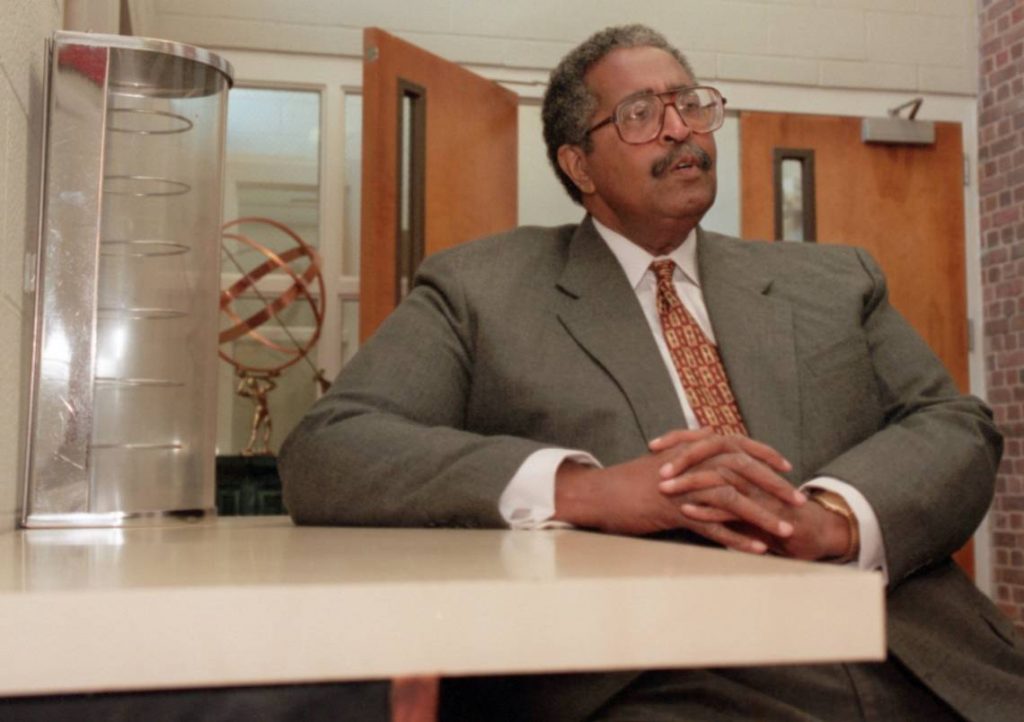
DURHAM, NC — 11/17/99 — Franklin McCain, one of the original lunch counter protesters from the Greensboro Woolworth, sits in a small portion of the lunch counter from the Durham Woolworth, which is at NCCU now in the Jones Building. Vicki Cheng story. JOHN ROTTET JOHN ROTTET
A PERSONAL JOURNEY
Crump, 62, has faced his own fight.
He’s battled colon cancer for more than a year, first privately and then more publicly. He continues to undergo chemotherapy and wrote the scripts for the documentaries from a hospital bed set up at his home.
For Crump, the stories he tells in these and other documentaries hit close to home.
“My dad came home from the (Korean) war. He has to ride in the back of a bus, didn’t have the right to vote and couldn’t sit down at a lunch counter,” Crump said in a recent interview in an empty studio at WBTV. “I didn’t have the opportunity to sit-in. I probably would have.”
To him there’s a straight line from that winter day in Greensboro to a historic photograph in the John Lewis documentary: President Lyndon Johnson signing the 1964 Civil Rights Act.
“As a result of the action these courageous students took, the impact was changing laws regarding segregation and redefining public policy,” Crump said.
Both documentaries feature Crump’s archival interviews with McCain, who died in 2014, and Charles Jones, a civil rights activist from Charlotte who died in January. Crump was a friend of each. He was a pallbearer for McCain and spoke at Jones’ funeral.
“Steve is an institution, especially in the black community,” said Glenn Burkins, publisher of Qcitymetro, an online news site aimed at African Americans.
“So often our stories don’t get told and when they are told they aren’t told by us. What Steve has done is turn that narrative on its head. He’s an African American newsman, journalist (and) story-teller who is telling our story. And that mean a lot.”
Some of those stories are frequently overlooked.
“Often we assume that history is what’s in the history books,” said historian Tom Hanchett. “History is what we create in our community. The civil rights movement, as much as we talk about Martin Luther King and Rosa Parks, was bubbling in every African American community in the United States.”
Crump said the prospect of his own mortality has given new resonance to his documentaries and the movement they chronicle.
“If you use the time you have left to inspire and make people think and to bring about change,” he said, “hopefully it’s time well spent.”
The Franklin McCain documentary will debut Feb. 5 at the Harvey B. Gantt Center. It airs on WBTV Bounce 7 p.m. Feb. 20.
The John Lewis documentary will air on WBTV Bounce 7:30 p.m. Feb. 20 and on WBTV 7:30 p.m. Feb. 21.
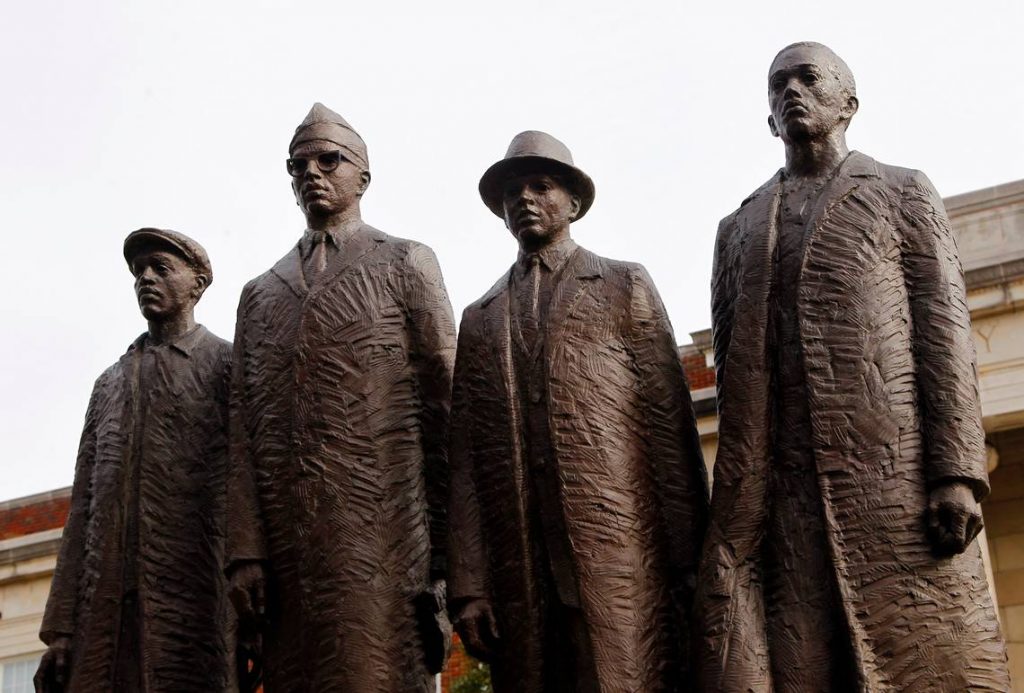
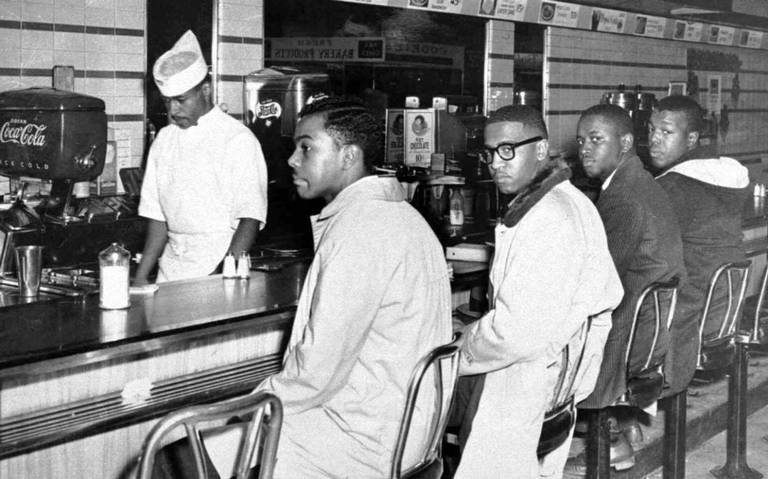
A group of 20 A&T College students occupied lunch counter seats at the downtown F.W. Woolworth Co. store. They are, from left, Joseph McNeil, Franklin McCain, Billy Smith and Clarence Henderson. JACK MOEBES/NEWS & RECORD
Jim Morrill, who grew up near Chicago, covers state and local politics. He’s worked at the Observer since 1981 and taught courses on North Carolina politics at UNC Charlotte and Davidson College.
? Portraits of Venezuelan Families Reframe the Harrowing Journey of Immigrants
January 10, 2020 Grace Ebert
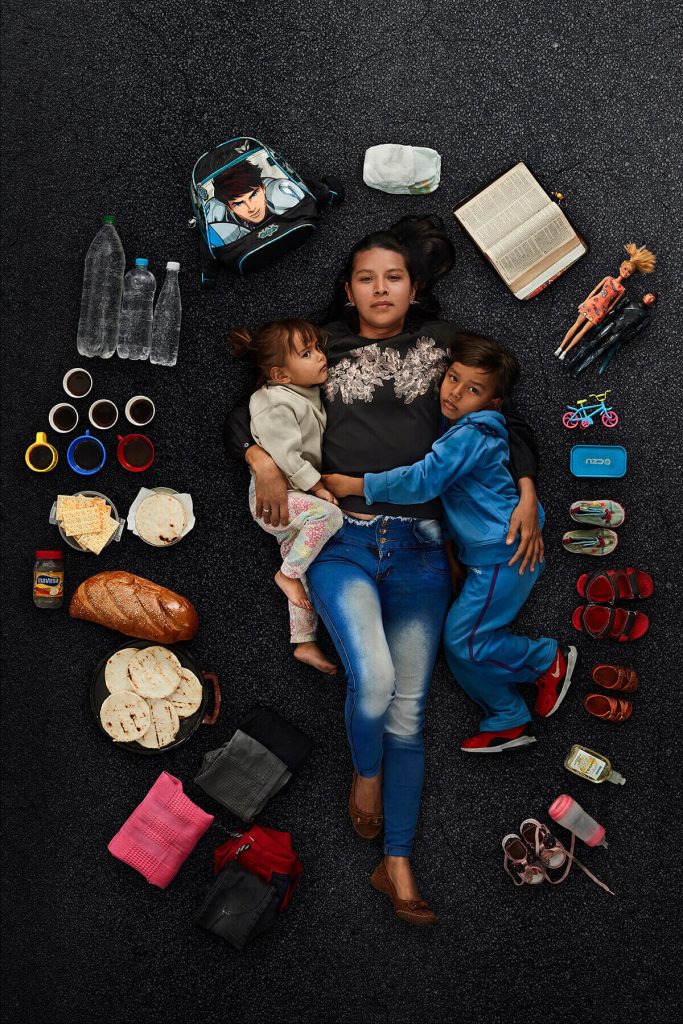
“Arianny Torres packed a few changes of clothes, a couple toys, medicine, diapers, a baby bottle, photos of relatives and her bible into her backpack. With her son, Lucas and daughter, Alesia, she traveled 976 kilometers from Maracaibo to Bogotá. Sometimes they hitched a ride. Other times they caught a bus, cutting into the small amount of money Arianny had put aside for food. Now she sells candy in Bolivar Square and though things could be better, at least life is more stable than it was in Venezuela and her kids are able to eat three times a day. I see Arianny’s determination to find a more hopeful life in her fixed gaze.” All images © Gregg Segal, shared with permission
In his Undaily Bread series, Gregg Segal photographs Venezuelan immigrants with the entirety of their belongings lying around them. Created in collaboration with UNHCR, an organization that helps refugees worldwide, the affective project shows a glimpse at what life as a Venezuelan refugee looks like, from the meager ingredients of their daily meals to the battered sneakers on their feet. Every image posted on Segal’s Instagram also includes a lengthy caption describing each family’s difficult journey.
“For me, photography communicates better than simply words. Statistics are important, but people are not that interested in statistics,” Segal tells Colossal. “They’re emotional because they describe how little the people have.” This consequential series is an offshoot of Daily Bread, Segal’s well-known project that captures images of kids from around the world surrounded by what they eat each day.

“Nathalia Rodriguez (9) who walked from Barquisimeto, Venezuela to Bogota with her mom, ate only bread, crackers, arepas, chips, water, juice, lollipops and the one fruit they could afford, bananas. It’s been 3 years since Nathalia’s eaten an apple. Apples run 5,000 Bolivas now in Venezuela, about $12 US. Despite the harsh road she traveled, Nathalia projects resilience and resolve.”

“Yosiahanny’s daughter feels for the kick of her brother or sister in her mother’s womb. They made the journey from Venezuela surviving on arepas and water. Though life in Bogotá is difficult, Yosiahanny is grateful she’s able to eat more than once a day. What makes the crisis tolerable is love, she says.”

“When I met 7 year old Williams, he showed me his backpack in which he carried a few things from home including his last homework assignment. He misses his grandmother’s arepas and stewed chicken. On the long walk from Venezuela, there was only bread, water, cookies and fruit to eat.”

“Michell, a single mom, made the trip with her two kids twice. During the 2nd attempt, Michell had an epileptic seizure and lost consciousness. 16 days later she made it to Bogotá and was admitted. In her portrait, Michell contends with the dueling energy of her kids, trying to soothe her daughter while her son appears to be driving the bus. After the shoot, her little boy held onto two loaves of bread, carrying them around the studio, tucked under his arms for later.”
October 12, 2016 Christopher Jobson

Acilius diving beetle male front tarsus (foot) 100x
If you’ve ever wondered how a diving beetle swims through the water or manages to rest just on the surface, the answer is in part because its foot is infinitely more complicated than your own. As seen above, this microscopic image of a male Acilius sulcatus (diving beetle) by photographer Igor Siwanowicz reveals the extraordinary complexity of this aquatic insect’s tiny appendage. This is just one of many examples of Siwanowicz’s work as a neurobiologist at the Howard Hughes Medical Institute’s Janelia Farm Research Campus. His brilliantly colored images show the tree-like structures of moth antennas, the wild details of barnacle legs, and the otherworldly shapes of plant spores. The photos are made with a confocal laser-scanning microscope capable of “seeing” vast amounts of detail beyond what you might capture with a traditional lens-based microscope. You can see much more of his nature photography here. (via Synaptic Stimuli, Wired)

Barnacle
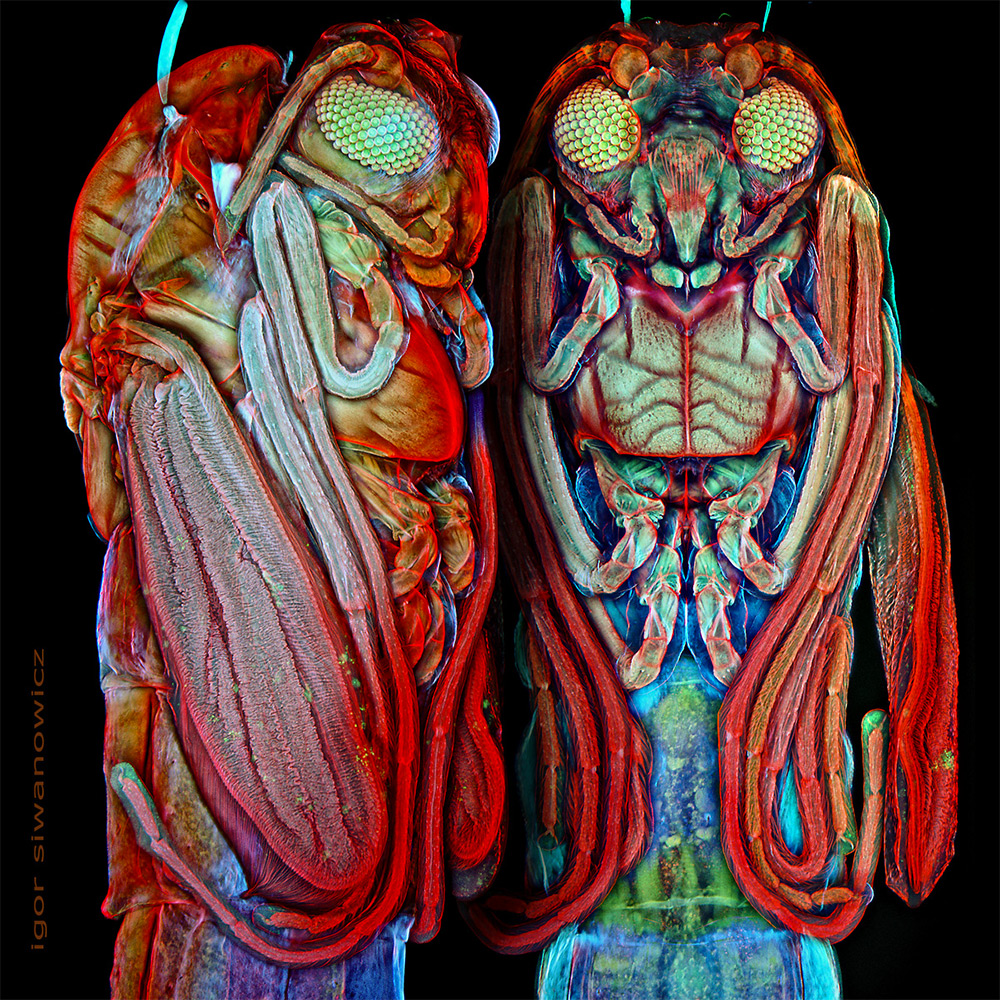
Midge Pupa

Paraphyses & Sporangia
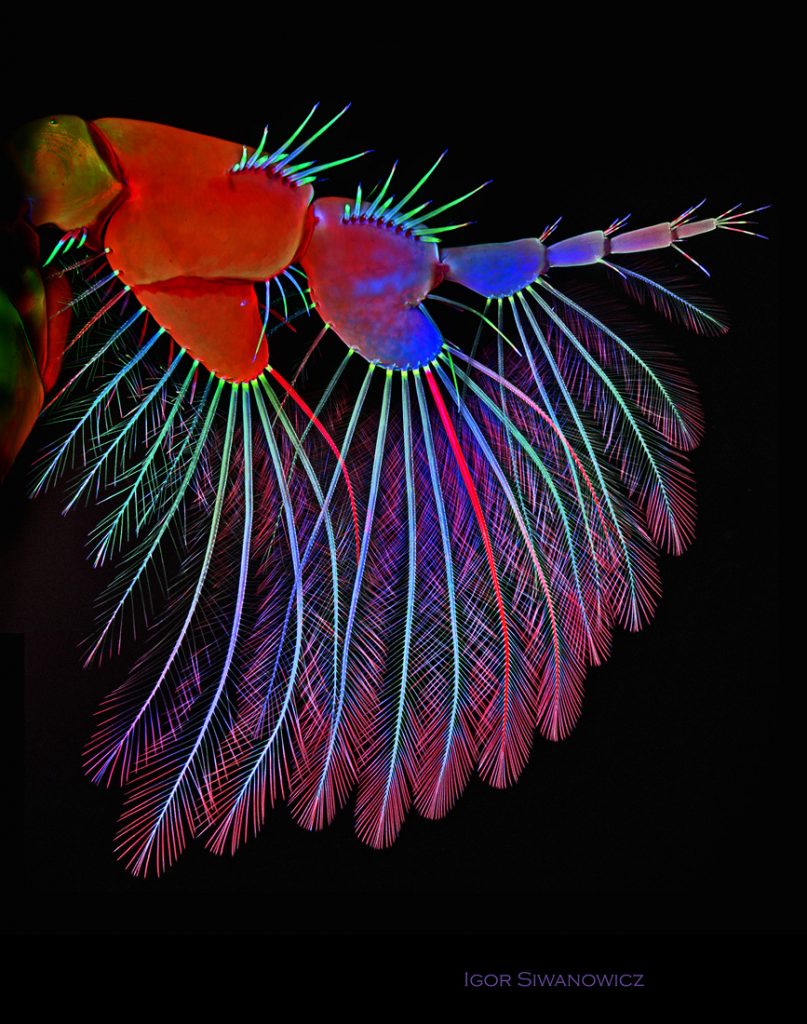
Isopod appendage

Front leg of whirligig beetle
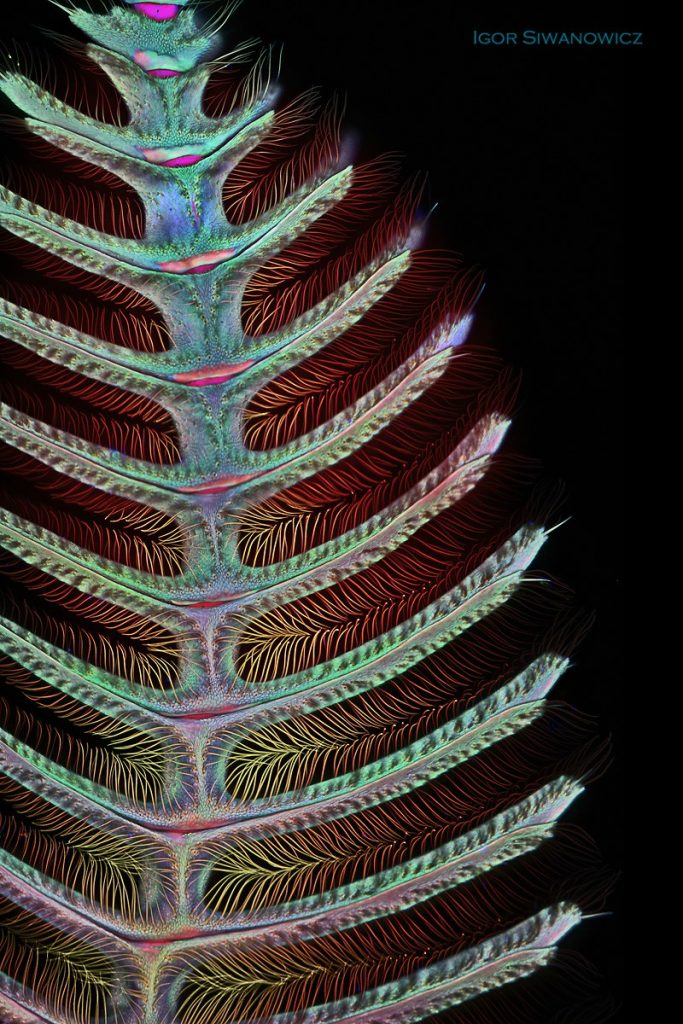
Moth antennae

Moth antennae, detail
? Striking Photographs Capture Ornate Patterns of Historic Iranian Mosques and Palaces
December 30, 2019 Grace Ebert

All images © Fatemeh Hosein Aghaei, shared with permission. Sheikh Lotfollah Mosque in Isfahan, Iran
Iran-based artist Fatemeh Hosein Aghaei takes mesmerizing photographs that showcase the intricate patterns inside the country’s ancient buildings. The artist mostly features mosques in the Iranian city of Isfahan, which is located about 250 miles south of Tehran and is known for its Perso–Islamic designed structures, boulevards, covered bridges, palaces, tile-filled mosques, and minarets. In her photographs, Hosein Aghaei often looks upward to frame the building’s domes and arches complete with complex colorful designs, sometimes even adding glimpses of the city’s blue skies. The artist tells Colossal that she wants her work to capture and share the beauty of Iran’s historic architecture. Keep up with Hosein Aghaei’s captivating images on Instagram.

Sheykh Abdussamad Mausoleum

Sheikh Lotfollah Mosque in Isfahan, Iran

Dowlatabad Garden of Yazd

Ali Qapu Palace of Isfahan, Iran

Jameh Mosque of Isfahan, Iran

Emam Mosque of Isfahan, Iran

Agha Bozorg Mosque of Kashan

Agha Bozorg Mosque of Kashan
? Forest Creatures Gather Together to Perform a Moonlit Rendition of an Opera
October 31, 2019 Laura Staugaitis

A songbird soloist accompanied by choruses of toads, turtles, and hedgehogs are conducted by a squirrel in Maestro, a delightful new animated short by Illogic. Set in a moonlit forest, the wild symphony performs a war anthem from Vincenzo Bellini’s opera Norma. In an interview with Vimeo, the team explained that they sought to balance imaginativeness with believability within the confines of their realistic universe. Illogic is based in Montpellier, France, where they recently opened an animation studio called Bloom Pictures. Take a behind-the-scenes look at how Maestro was made in the video below, and see more from Illogic, including the Oscar-nominated Garden Party, on Vimeo.


A Bloom Pictures short film directed by Illogic.
“Maestro” is this week’s Staff Pick Premiere. Read more about it on the Vimeo Blog: vimeo.com/blog/post/staff-pick-premiere-maestro-from-illogic
Making of :
vimeo.com/bloompictures/maestromakingof
Musical adaptation : Mael Oudin
Sound editing : Jérôme Navarro
Sound mixing : Studio le Refuge
You want to collaborate?
Send us a message at : hello@bloompictures.tv
For festivals and screenings, please
contact :
festival@miyu.fr
Press/Media requests :
benoit@animationshowcase.com
©Bloom Pictures 2019
Maestro – Making of
A Bloom Pictures short film directed by Illogic.
Maestro link :
vimeo.com/bloompictures/maestro
You want to collaborate?
Send us a message at : hello@bloompictures.tv
For festivals and screenings, please
contact :
festival@miyu.fr
Press/Media requests :
benoit@animationshowcase.com
©Bloom Pictures 2019
https://vimeo.com/bloompictures
Garden Party
Leave a Reply